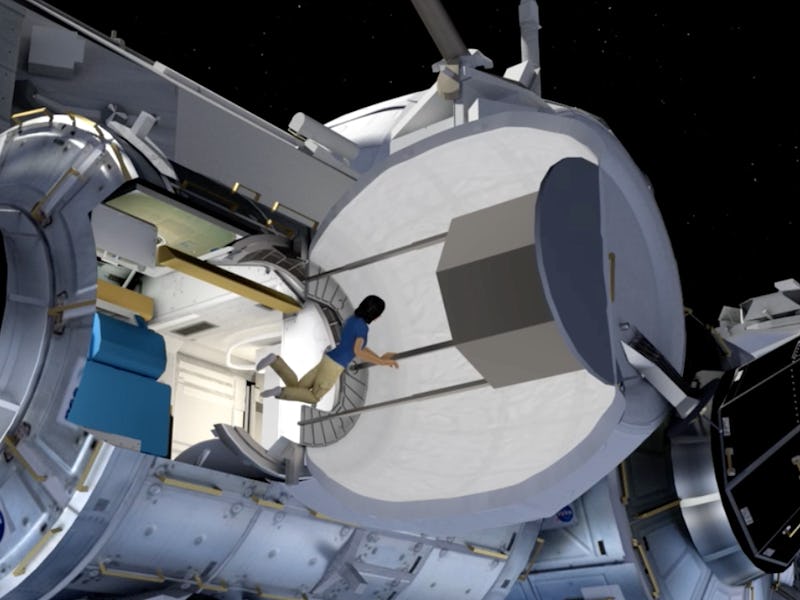BEAM Me Up: NASA to Send Inflatable Living Module to the ISS
Future space homes will be made the same way we throw children's birthday parties.

You know what’s harder than launching something into space? Building something in space. Just think about it: you have no gravity up there to keep any objects still. You can’t rely on the mere fact that things will stack on top of one-another and, you know, stay. Everything has to be glued together, so to speak — lest it come loose and threaten to allow the entire structure to come apart.
So what if instead of building something up in zero-gravity, you just inflate it? You know, launch it into space in a compressed state, then blow it up in orbit? NASA seems to think it might just work.
Yes, the premier space agency wants to pursue technologies that would create habitats in space the same way you create a moon bounce. That’s why, during next week’s SpaceX mission to the International Space Station, NASA is sending up the Bigelow Expandable Activity Module, or BEAM — a new module that will be stuffed and stored in a compressed state aboard a rocket, and then allowed to grow into its full state while docked to the ISS.
This artist's concept depicts the Bigelow Expandable Activity Module (BEAM).
Astronauts will spend two years testing out BEAM while it remains docked to the ISS, before it’s jettisoned out and allowed to burn up in the Earth’s atmosphere a couple hundred days later.
Expandable habitats require a minimum amount of space onboard a spacecraft hurtling out into space, but can then grow to their normal size once they are up there. According to NASA’s BEAM project manager Rajib Dasgupta, the module is capable of expanding up to 10 times its initial volume. At the size of 16 cubic meters (the size of small bedroom), BEAM “can potentially provide a comfortable area for astronauts to live and work,” Dasgupta told reporters on Monday.
Bigelow Aerospace (which worked with NASA to design the module) is seeking to test BEAM’s performance using a suite of special sensors. The type of data Bigelow and NASA want to collect includes dynamic load measurements, impact from debris, radiation, and temperature as it relates to the capabilities of the thermal insulation.
This is the installation in fast forward.
When BEAM is launched, the ISS crew on the ground will move the module from the SpaceX Dragon capsule’s trunk out to an aft node on the station using a robotic arm (above). When the crew is ready, they will get the go-ahead to expand BEAM out into its full size, which takes about 45 minutes:
Possible expansion scenarios for the BEAM module.
After the ventilation system is fired up, ISS astronauts will be allowed to venture into BEAM and will start collecting all kinds of scientific and technological data related to the performance of the module:
BEAM livin'
Though there might be a few initial drops of condensation here and there, the environment “overall will be the same as the ISS,” said Dasgupta.
In fact, BEAM will share the same airflow as the ISS. Although the hatch will be closed while astronauts are out of BEAM, the module is expected to work much like an additional room added to the rest of the station.
Of course, the ISS crew isn’t going to have the option of just making BEAM a permanent part of the station. The crew will have two years to test out BEAM, but they’ll be doing so very infrequently. Only two to three visits are scheduled for the first six months, and astronauts will only be venturing in for about three hours each time. Dasgupta says BEAM should be more than capable of sustaining the crew for much longer, but NASA has not yet given a green light for any such operations.
Lisa Kauke, the deputy program manager for BEAM at Bigelow Aerospace, was pretty tightlipped on technical specs, but she acknowledged that BEAM is fundamentally an updated version of the architecture first used on Genesis 1 and Genesis 2 — the first prototypes for inflatable space station modules previously designed by Bigelow and launched in 2006 and 2007, respectively. Both of those vehicles surpassed expectations, but they were limited by the fact that they could only expand radially, while BEAM inflates in multiple dimensions. Though both vehicles have stopped sending back data for some time now, they remain in orbit.
“We’re all very excited to see BEAM launched,” Dasgupta said on Monday.
The prospect of turning space construction into little more than a few buttons pushed and watching something inflate like a balloon means we couldn’t agree more.